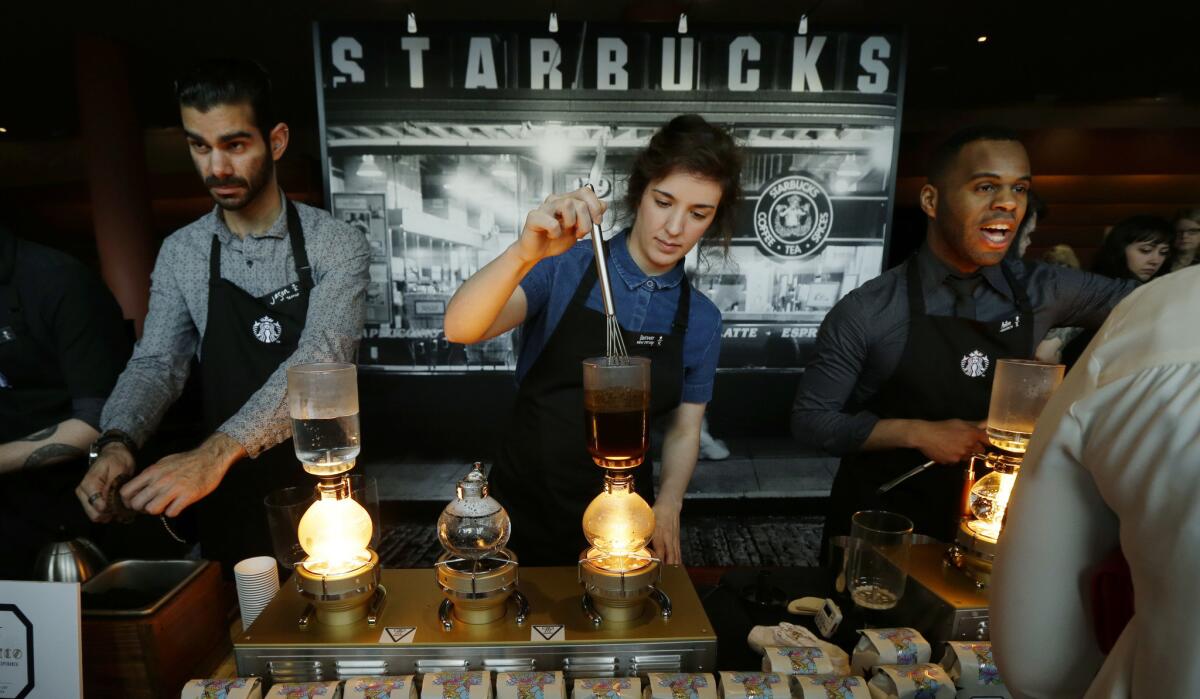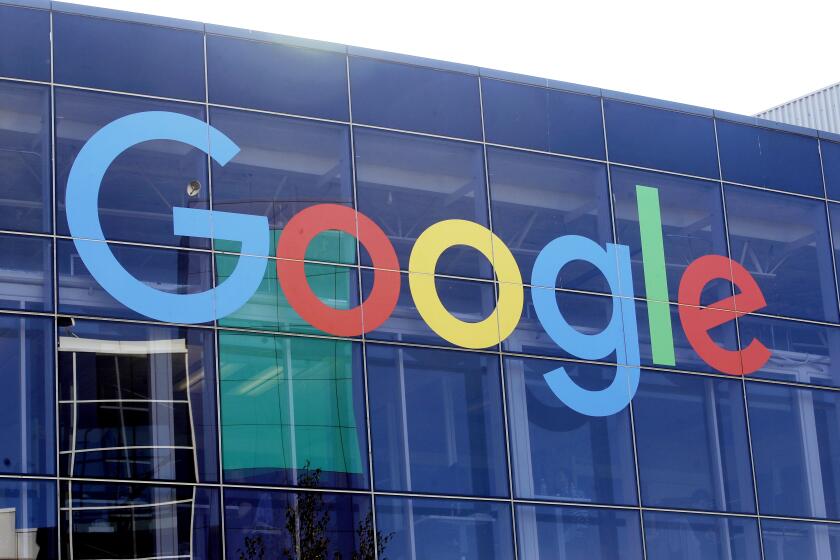Our long stagnant-paycheck nightmare may finally be nearing an end

- Share via
Reporting from Washington — For millions of Americans, a reminder of the economic damage of the Great Recession has arrived every week or two for years — in their paychecks.
Painfully slow wage growth has plagued the recovery, with many workers seeing few if any raises as they struggle to make ends meet. But there are signs that has started to change.
The falling unemployment rate has led to more competition for workers, spurring solid gains in average hourly earnings in recent months.
Those pressures, amplified by laws providing significant minimum-wage hikes in California, New York and elsewhere, also are triggering changes for the workers who need raises the most. Beginning last year, large companies such as Wal-Mart, Starbucks, McDonald’s and JPMorgan Chase increased what they pay their lowest-level employees.
A pay increase is the right thing to do.
— JPMorgan Chase Chief Executive Jamie Dimon
“A pay increase is the right thing to do,” JPMorgan Chase Chief Executive Jamie Dimon said recently in announcing raises that would bring the hourly pay of bank tellers, customer service representatives and other employees to at least $12 an hour in three years, from the current $10.15.
“Wages for many Americans have gone nowhere for too long,” he wrote in a New York Times opinion article.
The same message has emanated from the presidential campaigns of Republicans and Democrats as stagnating incomes have fueled voter frustration about the economy.
When adjusted for inflation, median annual household incomes declined to $53,657 in 2014, the most recent year for which government data are available, from $57,724 in 2000.
“Household incomes are more than $4,000 lower than their levels in the year 2000,” Republican nominee Donald Trump said at a rally in Virginia last month. “Think of it … you’re making $4,000 less now than you did 16, 17 years ago.”
Wage growth already was taking a hit this century for several reasons. One factor is the loss of bargaining power caused by a drop in the share of private-sector unionized workers; another is the decline in higher-paying manufacturing jobs as companies moved more factories abroad.
As a result, the share of money flowing into households from wages began falling sharply compared with capital income from interest and dividends, according to a study last year by the Federal Reserve Bank of Philadelphia.
The 2008 financial crisis and the worst economic downturn since the Great Depression amplified those changes, further stifling overall wage growth.
But after two years of strong job growth, job openings are near record levels. That’s forced employers to hike pay to attract new workers and retain existing ones, economists said.
Average hourly earnings increased 2.4% for the 12 months ended Aug. 31.
Annual wage gains have been consistently in that range since last fall -- they actually reached a seven-year high of 2.7% year-over-year in July — an improvement from the tepid 2% level during much the first six years of the recovery.
With annual inflation running below 1%, the accelerating wage growth is boosting workers’ purchasing power.
“We have turned the corner, and today the wage gains that are happening are far in excess of inflation,” said Andrew Chamberlain, chief economist at recruiting website Glassdoor.
“As long as we keep seeing steady job gains in the monthly jobs report and near-record job openings, it’s inevitable we’re going to see wage growth pick up,” he said.
Chamberlain said Glassdoor data show that competition for workers has pushed wage growth up sharply for some skilled professions. Pay for business system analysts is up about 10% compared with a year ago, while sales consultants saw a 7% gain and pharmacy technicians 6%.
Many of those sales consultants are in the technology industry, which saw average wages rise 3.6% last year in the 10 top markets, including Silicon Valley, Seattle, New York City and Los Angeles, according to a report from financial and professional services firm JLL.
The burgeoning Los Angeles tech industry showed the biggest increase in average annual pay — 13.2%, to $114,540, which includes benefits and stock options.
In addition, more middle-income jobs are being created than was the case earlier in the economic recovery, indicating that the wage gains are being spread more evenly among the workforce.
From 2010-13, new jobs that paid between about $30,000 and $50,000 annually lagged well behind high- and low-wage positions, according to research released recently by the Federal Reserve Bank of New York.
But from 2013-15, the U.S. added about 2.3 million middle-income jobs in fields such as construction, education, and transportation. During the same period, the economy created about 1.5 million high-paying jobs and about 1.6 million low-paying jobs.
“The tide has begun to turn,” William Dudley, president of the New York Fed, said in unveiling the study. “For the first time in quite a while, gains in middle-wage jobs actually outnumber gains in higher- and lower-wage jobs nationwide.”
But economists said there’s still a long way to go to get wages growing at a level to reverse the damage to household incomes from the recession.
“Wage growth is picking up, but it’s still below what you’d expect in a well-functioning economy,” said Mark Zandi, chief economist at Moody’s Analytics.
That level is about 3.5% a year. If the labor market continues to improve, the economy should start producing those types of wage gains in 2017, he said.
“That’s been the missing ingredient, the last step in the jobs recovery,” Zandi said.
Some states and localities have tried to accelerate that wage recovery for low-income workers by raising minimum wages. There now are 29 states, plus the District of Columbia, that have minimum wages higher than the federal level of $7.25 an hour, which hasn’t budged since 2009.
In April, Gov. Jerry Brown signed legislation that will raise the minimum wage in California to $15 an hour by 2022. On the same day, New York enacted legislation that will raise the minimum wage there to $15. The increases vary by region — faster for New York City, slower for more rural areas — and it is unclear when the entire state will hit that level.
See the most-read stories in Business this hour »
As the states with the nation’s largest and third-largest populations moved to increase their minimum wages, large companies realized that they’d soon have to raise the pay of many of their workers. That was one factor behind the nationwide pay raises that several began announcing last year.
“We certainly are mindful of wage increases in various states throughout the country,” McDonald’s chief financial officer Kevin M. Ozan told investors during an earnings call in July
“It has, from a purely business standpoint, created an incentive to lift the wages at the bottom across their workforces,” said Christine Owens, executive director of the National Employment Law Project, which has been pushing for a $15-an-hour minimum wage.
“A lot of companies … were getting a lot of bad press about how they treated their employees, and raising wages was an obvious way to respond to that,” she said.
Early last year, Wal-Mart became the first major employer to announce raises for its lowest-paid workers. It now pays them at least $10 an hour once they finish the company’s training program. Wal-Mart is spending $2.7 billion over two years to increase pay, bringing the average full-time hourly rate for its workers to $13.38.
Brett Biggs, the company’s chief financial officer, predicted the investment “will pay off long-term.”
“Whether it’s lower attrition rates in the stores, better motivated associates, we think we’ll see the benefits from that,” he told an investor conference in June.
Starbucks Chief Executive Howard Schultz cited similar reasons after announcing this summer that the company would raise base pay for its workers by at least 5% in October. The company’s baristas earn an average of about $9.40 an hour, according to Glassdoor.
“What we want to try and do is really get ahead of any federal or state mandate to be the employer of choice,” Schultz told analysts on an earnings call in July.
After saying last year that he opposed an increase in the federal minimum wage, Trump this summer said he thought it should be raised to at least $10. The Democratic Party’s official platform calls for increasing the federal minimum wage to $15.
“Raising the federal minimum wage won’t just put more money in the pockets of low-income families, it also means they will spend more at the businesses in their neighborhoods,” Democratic nominee Hillary Clinton told a Michigan crowd last month. “We need to get incomes and wages rising, and it will help the whole economy grow and be fairer.”
Follow @JimPuzzanghera on Twitter
MORE BUSINESS NEWS
SpaceX rocket exploded in an instant. Figuring out why involves a mountain of data
An HOA board does not have the authority to ban drought-tolerant landscaping
How to improve your spouse’s chances of a well-funded retirement
Dish Network, Tribune agree on carriage contract, ending blackout
More to Read
Inside the business of entertainment
The Wide Shot brings you news, analysis and insights on everything from streaming wars to production — and what it all means for the future.
You may occasionally receive promotional content from the Los Angeles Times.











